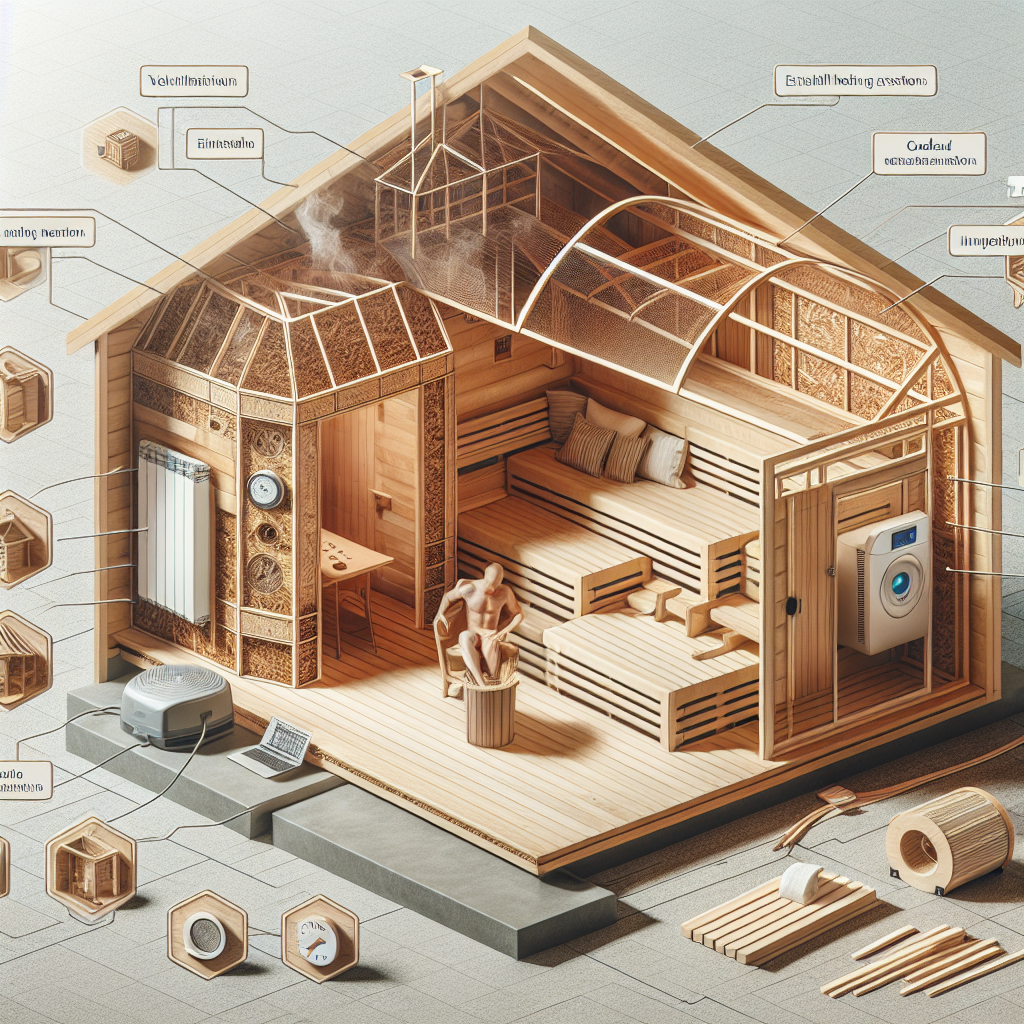Thinking about creating your own personal oasis right in the comfort of your own home? Look no further than building your very own sauna. Whether you crave some much-needed relaxation or want to reap the numerous health benefits, constructing a sauna at home can be a rewarding and worthwhile endeavor. But where do you begin?
In this article, we will explore some handy tips and insights to help you embark on this exciting project successfully and transform your home into a haven of warmth and serenity. So, get ready to immerse yourself in the world of home saunas and discover the secrets to building your dream space. Building a sauna at home can be an exciting and rewarding project. Not only does it offer a place to relax and unwind, but it also provides numerous health benefits.
However, before diving into the construction process, there are several factors to consider to ensure your sauna is the perfect addition to your home. In this article, we will guide you through the steps of choosing the right location, selecting the sauna type, designing the sauna, preparing the space, constructing the walls and ceiling, installing the sauna door, setting up the sauna bench, installing the sauna heater, and controlling temperature and humidity.
Additionally, we will provide tips on maintaining and cleaning your sauna to ensure its longevity.

Choosing the Right Location
The first step in building a sauna at home is to choose the right location. Consider the available space in your home and find an area that can accommodate your sauna comfortably. It’s important to ensure that the dimensions of the space align with the size of the sauna you have in mind. Additionally, take into account any structural limitations or building codes that may affect your sauna construction.
Alongside the available space, proper ventilation is crucial for a sauna. Be sure to choose a location that allows for adequate airflow. This will help to regulate temperature and humidity levels within the sauna and create a comfortable environment for relaxation.
Lastly, evaluate the proximity to water sources. Having easy access to water is essential for various sauna activities such as creating steam or cooling down. Consider the convenience and practicality of the location in relation to water sources to enhance your sauna experience.
Selecting the Sauna Type
Once you have chosen the location, it’s time to decide on the type of sauna that best suits your preferences and needs. There are three main types of saunas to choose from: traditional Finnish saunas, infrared saunas, and steam saunas.
Traditional Finnish saunas use a heated stove to produce steam, creating a hot and humid environment. These saunas are typically constructed with wood and offer an authentic sauna experience.
Infrared saunas use infrared light to heat the body directly, rather than heating the air. They operate at lower temperatures and are preferred by those who enjoy a milder sauna experience.
Steam saunas, also known as wet saunas, are designed to produce steam using a steam generator. These saunas offer a unique and relaxing experience with higher humidity levels.
Consider your personal preferences, health considerations, and desired temperature ranges when selecting the sauna type that will best meet your needs.
Designing the Sauna
Designing your sauna involves making several important decisions regarding its size, layout, materials, and features. The size of your sauna will depend on the available space and the number of people you wish to accommodate comfortably. Consider how many benches you would like, as well as any additional features such as a changing area or a relaxation zone.
When choosing materials, opt for those that can withstand the high temperatures and humidity levels of a sauna. Common materials include cedar, hemlock, and pine, which are known for their durability and resistance to moisture. Choose materials that are aesthetically pleasing and enhance the overall ambiance of your sauna.
Including necessary features and accessories in your sauna design will enhance your sauna experience. Consider adding features such as lighting, audio systems, and towel hooks. Additionally, accessories like sauna buckets, ladles, and thermometers can add functionality and convenience to your sauna.
Preparing the Space
Before diving into the construction process, it’s essential to prepare the space where your sauna will be located. Start by ensuring a level and sturdy foundation to support the weight of the sauna. This will prevent any structural issues and provide a solid base for your sauna construction.
Proper insulation is crucial to ensure an efficient sauna that retains heat effectively. Consider using insulation materials such as fiberglass or mineral wool between the sauna walls and the exterior wall frames. Plan for proper insulation in advance to avoid any heat loss and maximize energy efficiency.
Arranging for electrical and heating requirements is another crucial step in preparing the space. If you are not experienced in electrical work, it is recommended to hire a professional electrician to ensure the wiring and connections meet safety standards. Similarly, consult with a heating specialist to ensure the proper installation of your sauna heater and ventilation system.

Constructing the Sauna Walls and Ceiling
With the space prepared, it’s time to construct the walls and ceiling of your sauna. Start by installing the framework, ensuring that it is sturdy and able to support the weight of the sauna. Use appropriate materials, such as moisture-resistant wood, to prevent warping, cracking, or mold growth.
Attaching a vapor barrier is essential to prevent moisture from penetrating the walls and ceiling of your sauna. This barrier helps to maintain the desired humidity levels within the sauna and protects the structure from potential damage.
Applying the sauna lining is the final step in constructing the walls and ceiling. Cedar, hemlock, and other suitable sauna woods are commonly used for this purpose. Ensure that the lining is installed properly, creating a seamless and visually pleasing interior.
Installing the Sauna Door
Choosing the right sauna door is crucial for maintaining proper heat and humidity levels inside the sauna. Consider a door that is made of durable and heat-resistant materials, such as glass-reinforced plastic or solid wood. The door should fit snugly and have proper insulation to prevent heat loss.
In addition to a tight seal, it is important to consider safety and durability when selecting a sauna door. Opt for a door with tempered glass and sturdy hinges to ensure long-lasting performance. Furthermore, consider adding a window or glass panel to the door, which can enhance the aesthetic appeal and provide a sense of openness within the sauna.
Installing the Sauna Bench
The sauna bench is where you will be spending most of your time, so it is essential to carefully consider its layout, height, and materials. Decide on a bench layout that maximizes seating capacity while allowing for ease of movement. Opt for L-shaped or U-shaped configurations to optimize space utilization.
When it comes to materials, select those that are heat-resistant and comfortable to sit on. Cedar is a popular choice for benches, as it offers both durability and visual appeal. Ensure proper ventilation underneath the bench to prevent moisture buildup and ensure comfort during sauna sessions.
Setting up the Sauna Heater
Selecting the appropriate sauna heater is critical to ensure an enjoyable and safe sauna experience. Choose a heater type that aligns with your preferences and chosen sauna type. Electric heaters are commonly used as they are easy to install and control. However, if you prefer a more traditional feel, consider a wood-burning sauna heater.
Sizing the heather correctly is essential to maintain optimal temperature in your sauna. The heater capacity should be determined based on the size of your sauna, insulation, and your desired temperature range. Consult the manufacturer’s guidelines or seek professional advice to ensure the correct sizing for your sauna heater.
Follow the manufacturer’s instructions for the installation of the sauna heater. Improper installation can result in safety hazards and malfunctioning equipment. Due to the complexity of electrical and heating elements, it is recommended to seek professional help to ensure proper installation and adherence to safety codes.
Controlling Temperature and Humidity
To maintain a comfortable sauna environment, it is necessary to have proper temperature and humidity control. Install a thermostat and controls to regulate the temperature based on your preferences. Ensure that the thermostat is placed at an appropriate location within the sauna for accurate readings.
Proper ventilation is crucial to maintain the desired humidity levels and prevent stale air within the sauna. Install vents or fans to ensure adequate airflow, which will prevent excess humidity and maintain air quality. Regularly clean and maintain the ventilation system to avoid any blockages or malfunctions.
Using a hygrometer can help monitor and regulate the humidity levels within the sauna. This device provides real-time humidity readings, allowing you to adjust the temperature or add water as needed. Having control over the temperature and humidity will ensure a comfortable and enjoyable sauna experience.
Maintaining and Cleaning the Sauna
Regular maintenance and cleaning are essential to keep your sauna in optimal condition and extend its lifespan. Clean the sauna regularly to remove any dirt, debris, or sweat that may have accumulated. Wipe down the walls, benches, and floor using a mild cleaner and a soft cloth.
Inspect and replace sauna stones as needed. Over time, stones can become cracked or lose their effectiveness. Replace any damaged or worn stones to maintain the sauna’s heating efficiency and desired temperature range.
In addition to cleaning the sauna’s interior, it is important to keep the sauna heater and ventilation clean. Clean the heater regularly to remove any buildup of dust or debris that may affect its performance. Similarly, inspect and clean the ventilation system to ensure proper airflow and prevent the accumulation of mold or mildew.
By following these tips for building a sauna at home, you can create a space that offers both relaxation and therapeutic benefits. Whether you prefer a traditional Finnish sauna, an infrared sauna, or a steam sauna, careful consideration of the location, type, design, and maintenance will result in a sauna that enhances your overall well-being. Take the time to plan and execute each step with precision, and soon you’ll have a personal oasis right in the comfort of your own home.

